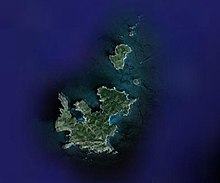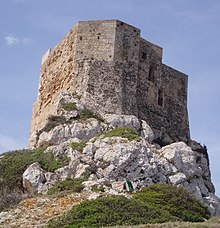Archipiélago de Cabrera National Park
The Archipiélago de Cabrera National Park (in Spanish Parque Nacional Marítimo-Terrestre del Archipiélago de Cabrera , in Catalan Parc Nacional Maritimoterrestre de l'Arxipèlag de Cabrera ) consists of a group of small islands that belong to the Balearic Islands . It was established on April 29, 1991 by Law 14/1991. The national park has an area of 10,021 hectares, 8,703 hectares of which are in the sea and 1,318 on land.
The coasts of the Cabrera Islands are considered to be the most pristine in Spain. The islands have large colonies of sea birds and some endemic animal and plant species. The Cabrera National Park is also a European bird sanctuary .
geography
The Cabrera archipelago is ten kilometers from the Cap de les Salines , the southern tip of Mallorca. Geologically, the islands are the southern extension of the Serres de Llevant Mountains . The archipelago includes 19 islands and islets. The largest is Cabrera Gran with 1,155 hectares, followed by Illa des Conills with 137 hectares. Other larger islands are Ses Rates , els Estels , l'Imperial , les Bledes , es Fonoll , na Rodona , l'Esponja , na Plana , na Pobra , s'Illot Pla , s'Illot and na Foradada .
The climate is semi-arid , the islands are exposed to wind and sea salt.
vegetation
The potential natural vegetation of the islands is a Garriga with wild olive trees , which Ullastrar is called. In Ullastrar more shrubs grow with small, leathery leaves as Phoenician juniper ( Juniperus phoenicea subsp. Turbinata ), mastic , rosemary , the buckthorn -Art Rhamnus ludovici-salvatoris , Erica multiflora that Ephedra -Art Ephedra fragilis , tree spurge and giant fennel . This type of vegetation can only be found scattered. Aleppo pines are planted on around a third of the area of Cabrera Gran .
Typical of the vegetation on the cliffs are the thorny cushions of Astragalus ( Astragalus balearicus ), germander ( Teucrium subespinosum ) and dorycnium ( Dorycnium fulgurans ). The tree-shaped poplar ( Lavatera arborea ) and the shrub snail ( Medicago arborea subsp. Citrina ) also thrive here . A subspecies of a dye red species ( Rubia angustifolia caespitosa ) occurs exclusively on Cabrera.
Underwater meadows made of Mediterranean Neptune grass ( Posidonia oceanica ) and various algae are characteristic of the marine area around the Cabrera Islands. In the clear water, they grow at depths of up to 45 meters.
Wildlife
The islands of the Cabrera archipelago are an important stop for many migratory birds. Every spring the Grup Balear d'Ornitologia i Defensa de la Naturalesa carries out a large ringing campaign here. In contrast, the number of bird species that breed on the islands is quite low at 26. These include osprey , Eleanor's falcon and peregrine falcon . There are about 400 breeding pairs of the coral gull and 1500 breeding pairs of the Mediterranean seagull . Between 80 and 140 pairs of the Balearic Shearwaters breed on the islands of Conillera and Fonoll . Yellow-billed shearwaters , petrels and common shags also breed on the archipelago .
Bird species that are not tied to the sea include the triel , blue roe , Sardinian warbler , whitebeared warbler , velvet warbler and graycatcher . Goldfinches , greenlings and bloodlines are common.
With the exception of some bat species, all land-dwelling mammals on the Cabrera Islands were introduced by humans. Today, for example, rabbits , the gorse cat and feral domestic cats can be found there. The Balearic Lizard ( Podarcis lilfordi ) has split into different subspecies on the islands.
Bottlenose dolphins , common dolphins , blue and white dolphins , pilot whales and the occasional sperm whale can be found in the sea around the islands . The Mediterranean monk seal had one of its last occurrences on the Cabrera Islands. More than 200 species of fish and around 1000 invertebrates live in the waters around Cabrera . The loggerhead turtle is one of the most striking marine life .
Problems
The national park administration tries to control the population of some animal species that are overpowering or damaging the ecosystem. These include the pine processionary moth , the house rat and the Mediterranean seagull. In strong winds and drought, bush fires can devastate larger areas. A lot of rubbish is washed ashore on the coasts of the Cabrera Islands, which is stored on Cabrera Gran for a long time until it is removed.
use
fishing
The use and management plan (Plan Rector de Uso y Gestión (PRUG)) of the national park allows traditional "artisanal" fishing.
Visitors
Between April 1st and October 30th, the island of Cabrera can be reached by ferryboat that leaves from the ports of Palma , Colonia de Sant Jordi and Porto Petro according to the timetable. Boats are allowed to call at Cabrera Gran all year round; a permit from the national park administration in Palma de Mallorca must be obtained for this. Divers also need a permit. National park staff offer free tours of the interior of the island. The information center of the National Park is located in Colonia de Sant Jordi (see also: Sights of Ses Salines ).
| 1995 | 1996 | 1997 | 1998 | 1999 | 2000 | 2001 | 2002 | 2003 | 2004 | 2005 | 2006 | 2007 | 2008 | 2009 | ||||||||
| 36.173 | 39,265 | 43,215 | 52,796 | 47,302 | 44,983 | 64,068 | 66,302 | 66,535 | 73,540 | 71,987 | 74,532 | 76,541 | 60,804 | 60,662 | ||||||||
| 2010 | 2011 | 2012 | 2013 | 2014 | 2015 | 2016 | 2017 | |||||||||||||||
| 64,688 | 75,544 | 108.188 | 67,809 | 108.038 | 120.905 | 121.189 | 126.143 | |||||||||||||||
| * Data from websites of the Spanish Ministry of the Environment | ||||||||||||||||||||||
proof
- ↑ a b c d e Oriol Alamany, Eulàlia Vicens: Parques Nacionales de España . Lynx Edicions , Barcelona 2003, ISBN 84-87334-45-8
- ↑ elmundo.es: ¿Parque natural o vertedero de lujo? . August 25, 2008
- ↑ Juanjo Alonso: Rutas por los Parques Nacionales de España y Portugal . Santillana Ediciones Generales, Madrid, 2009, ISBN 978-84-03-50841-5
- ^ Ministerio de Medio Ambiente: Evolución del número de visitantes (1996-2007) ( Memento of April 21, 2008 in the Internet Archive ).
- ↑ Ministerio de Agricultura, Alimentación y Medio Ambiente: Datos de visitantes a los Parques Nacionales , accessed on September 15, 2018.
Web links
- Official website of the Parque Nacional del Archipiélago de Cabrera
- Cabrera. www.mallorcaweb.com, October 11, 2004, accessed November 9, 2011 (Catalan).
- IslasBaleares: Map of the Cabrera Archipelago
- Information center official website accessed April 9, 2015 (Spanish)
Coordinates: 39 ° 9 ' N , 2 ° 58' E


